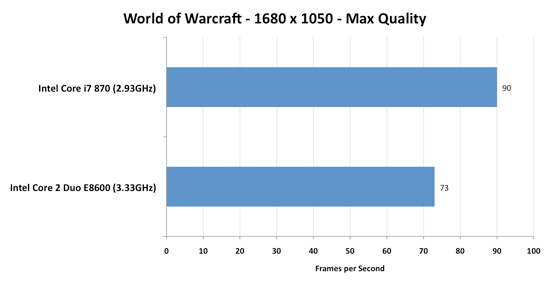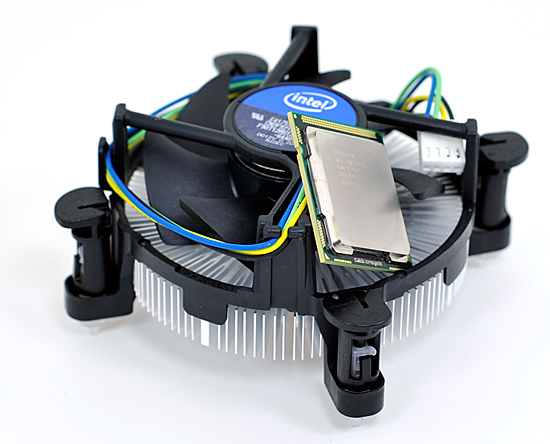Intel's Core i7 870 & i5 750, Lynnfield: Harder, Better, Faster Stronger
by Anand Lal Shimpi on September 8, 2009 12:00 AM EST- Posted in
- CPUs
Lynnfield's Turbo Mode: Up to 17% More Performance
Turbo on Bloomfield (the first Core i7) wasn't all that impressive. If you look back at our Core i7 article from last year you'll see that it's responsible for a 2 - 5% increase in performance depending on the application. All Bloomfield desktop CPUs had 130W TDPs, so each individual core had a bit more breathing room for how fast it could run. Lynnfield brings the TDP down around 27%, meaning each core gets less TDP to work with (the lower the TDP, the greater potential there is for turbo). That combined with almost a full year of improving yields on Nehalem means that Intel can be much more aggressive with Turbo on Lynnfield.
| SYSMark 2007: Overall | Dawn of War II | Sacred 2 | World of Warcraft | |
| Intel Core i7 870 Turbo Disabled | 206 | 74.3 fps | 84.8 fps | 60.6 fps |
| Intel Core i7 870 Turbo Enabled | 233 | 81.0 fps | 97.4 fps | 70.7 fps |
| % Increase from Turbo | 13.1% | 9.0% | 14.9% | 16.7% |
Turbo on Lynnfield can yield up to an extra 17% performance depending on the application. The biggest gains will be when running one or two threads as you can see from the table below:
| Max Speed | Stock | 4 Cores Active | 3 Cores Active | 2 Cores Active | 1 Core Active |
| Intel Core i7 870 | 2.93GHz | 3.20GHz | 3.20GHz | 3.46GHz | 3.60GHz |
| Intel Core i7 860 | 2.80GHz | 2.93GHz | 2.93GHz | 3.33GHz | 3.46GHz |
| Intel Core i5 750 | 2.66GHz | 2.80GHz | 2.80GHz | 3.20GHz | 3.20GHz |
If Intel had Turbo mode back when dual-cores first started shipping we would've never had the whole single vs. dual core debate. If you're running a single thread, this 774M transistor beast will turn off three of its cores and run its single active core at up to 3.6GHz. That's faster than the fastest Core 2 Duo on the market today.

WoW doesn't stress more than 2 cores, Turbo mode helps ensure the i7 870 is faster than Intel's fastest dual-core CPU
It's more than just individual application performance however, Lynnfield's turbo modes can kick in when just interacting with the OS or an application. Single threads, regardless of nature, can now execute at 3.6GHz instead of 2.93GHz. It's the epitomy of Intel's hurry up and get idle philosophy.
The ultimate goal is to always deliver the best performance regardless of how threaded (or not) the workload is. Buying more cores shouldn't get you lower clock speeds, just more flexibility. The top end Lynnfield is like buying a 3.46GHz dual-core processor that can also run well threaded code at 2.93GHz.
Take this one step further and imagine what happens when you have a CPU/GPU on the same package or better yet, on the same die. Need more GPU power? Underclock the CPU cores, need more CPU power? Turn off half the GPU cores. It's always availble, real-time-configurable processing power. That's the goal and Lynnfield is the first real step in that direction.
Speed Limits: Things That Will Keep Turbo Mode from Working
As awesome as it is, Turbo doesn't work 100% of the time, its usefulness varies on a number of factors including the instruction mix of active threads and processor cooling.
The actual instructions being executed by each core will determine the amount of current drawn and total TDP of the processor. For example, video encoding uses a lot of SSE instructions which in turn keep the SSE units busy on the chip; the front end remains idle and is clock gated, so power is saved there. The resulting power savings are translated into higher clock frequency. Intel tells us that video encoding should see the maximum improvement of two bins with all four cores active.
Floating point code stresses both the front end and back end of the pipe, here we should expect to see only a 133MHz increase from turbo mode if any at all. In short, you can't simply look at whether an app uses one, two or more threads. It's what the app does that matters.
There's also the issue of background threads running in the OS. Although your foreground app may only use a single thread, there are usually dozens (if not hundreds) of active threads on your system at any time. Just a few of those being scheduled on sleeping cores will wake them up and limit your max turbo frequency (Windows 7 is allegedly better at not doing this).
You can't really control the instruction mix of the apps you run or how well they're threaded, but this last point you can control: cooling. The sort-of trump all feature that you have to respect is Intel's thermal throttling. If the CPU ever gets too hot, it will automatically reduce its clock speed in order to avoid damaging the processor; this includes a clock speed increase due to turbo mode.

Lynnfield and its retail cooler
The retail cooler that ships with the Core i7 is tiny and while it's able to remove heat well enough to allow the chip to turbo up, we've seen instances where it doesn't turbo as well due to cooling issues. Just like we recommended in the Bloomfield days, an aftermarket cooler may suit you well.
Lynnfield: Made for Windows 7 (or vice versa)
Core Parking is a feature included in Windows 7 and enabled on any multi-socket machine or any system with Hyper Threading enabled (e.g. Pentium 4, Atom, Core i7). The feature looks at the performance penalty from migrating a thread from one core to another; if the fall looks too dangerous, Windows 7 won't jump - the thread will stay parked on that core.
What this fixes are a number of the situations where enabling Hyper Threading will reduce performance thanks to Windows moving a thread from a physical core to a logical core. This also helps multi-socket systems where moving a thread from one core to the next might mean moving it (and all of its data) from one memory controller to another one on an adjacent socket.
Core Parking can't help an application that manually assigns affinity to a core. We've still seen situations where HT reduces performance under Windows 7 for example with AutoCAD 2010 and World of Warcraft.
With support in the OS however, developers should have no reason to assign affinity in software - the OS is now smart enough to properly handle multi-socket and HT enabled machines.










343 Comments
View All Comments
Supershanks - Thursday, September 10, 2009 - link
Great Article Anand, I read it with great interest.However I found somthing that was strange and unexpected today
My I7-860 was running at 30x133 3990 when running nucleus, that's according to cPU-z I have a link , but can't post http in this comment ?
http://www.clunk.org.uk/forums/reviews/24295-asus-...">http://www.clunk.org.uk/forums/reviews/...-deluxe-...
I'd appreciate your insight ?
thanks
Gary Key - Thursday, September 10, 2009 - link
You need to change your version of CPU-Z. I have a screenshot somewhere around here of 48x133. ;)Scali - Thursday, September 10, 2009 - link
On a slightly related note... With these new P55 boards I see that especially Asus uses a new line of onboard audio chips from VIA.I haven't really been able to find much info on these chips. I'd like to know how they compare to Realtek and other onboard offerings.
Could you guys spend some time on reviewing the onboard audio next time you review one of these boards? Eg, what does the control panel for these chips look like, what features does it have (eg, can you have realtime encoding like DTS connect or DD Live?), what is the general driver quality like (proper support of 3d/eax effects etc)?
I think that's what's been missing in general, the past few years. Onboard audio has gotten quite advanced, to the point where most people no longer use a separate soundcard (some boards actually come with some sort of X-Fi card). However, I rarely see onboard audio reviewed, only audio cards.
agawtrip - Thursday, September 10, 2009 - link
for me, i find this review is misleading if you are not a gamer - for i5-750 and PII x4 965.why?
1. motherboard and video card - non-gamer dont buy sli/xfire board. onboard graphics is fine(780g/785g). for now, boards for i5 setup doesn't have onboard graphics. what will you do? you will be forced to buy a video card (maybe 4550/9400gt for $40).
i5-750 - $195, GIGABYTE GA-P55M-UD4 - $150, nvidi 9400gt - $40
--- TOTAL -------- $385
PII x4 965 - $245, GIGABYTE GA-MA785GMT-UD2H - $90, no video card
--- TOTAL -------- $335
AMD setup is actually cheaper but slower. it's all up to you.
2. power consumption - since you are forced to buy video card, it will consume additional power while AMD setup (780/785G) won't.
well that's just my opinion.
please inform me and the others if i given up wrong informatin
chrnochime - Thursday, September 10, 2009 - link
Or you can get a motherboard that's quite a bit cheaper:MSI P55-CD53
http://www.newegg.com/Product/Product.aspx?Item=N8...">http://www.newegg.com/Product/Product.aspx?Item=N8...
which is 120..
or
GIGABYTE GA-P55M-UD2
http://www.newegg.com/Product/Product.aspx?Item=N8...">http://www.newegg.com/Product/Product.aspx?Item=N8...
And yes I know these are NE prices, and that it might be more expensive/cheaper somewhere else
Hrel - Wednesday, September 9, 2009 - link
It DOES NOT have hyperthreading. Enabling it wouldn't increase the cost of the chip, it purely a political move. I HATE that! If a CPU maker has something that can increase the performance of my cpu, at no cost to them, then should enable it, at no cost to me. EVERY CPU should have unlocked multipliers. EVERY CPU should have hyperthreading.jnr0077 - Friday, July 27, 2012 - link
hyperthreading steal ram from your pc i have a i5 750 + radeon hd 4850 it plays crysis 2 maxed the witcher 2 maxed skyrim maxed i think you need to read up on it before you comment :)PhilTaylor - Wednesday, September 9, 2009 - link
FSX is well known as a CPU-limited game, it might be more interesting to test it then a GPU limited game like Crysis. For instance, the difference between 2 and 3 memory channels might have a greater impact on FSX, again due to its CPU-limited nature.cactusdog - Wednesday, September 9, 2009 - link
A very good, detailed bunch of tests but there is a surprising lack of information regarding temps? Other review sites have done the same thing but there IS temp issues with these CPUs as with i7 1366 ones. That CPU at 4.0 Ghz on air will be around 90 degrees but little is said.Anandtech is more honest than most review sites (most of which are really just advertisements) but sometimes i get the impression that nobody wants to upset Intel.
araczynski - Wednesday, September 9, 2009 - link
...bottom line to me, my E8500/crossfire setup still has plenty of gaming life left. I'll check back in a year.